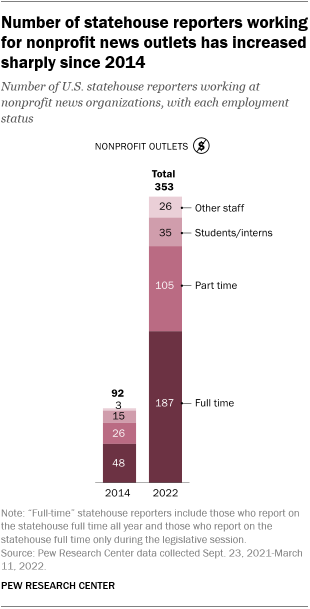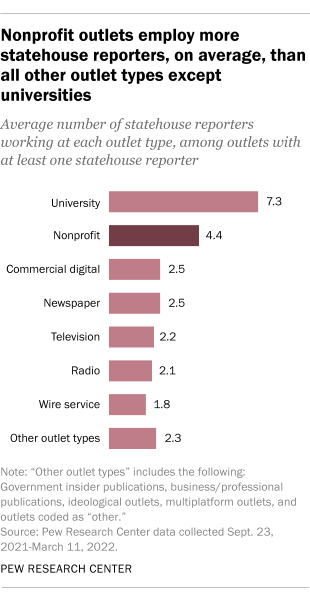
Nonprofit news organizations are playing an increasingly important role in covering state capitols, according to a recent Pew Research Center study. The number of nonprofit news reporters who cover state capitols has nearly quadrupled since 2014, and these journalists now account for 20% of the nation’s total statehouse press corps, up from 6% eight years ago. Nonprofit journalists are now the second-largest contingent of all statehouse reporters, following those who work for newspapers.
While the nonprofit outlets that employ these statehouse reporters all have a digital presence, many reach their audiences in a variety of ways, including newsletters, print publications and podcasts. Many also allow other outlets to republish their original reporting, often at no cost.
A closer look at nonprofit news organizations that cover state government shows that they often focus on specific topics of coverage, such as immigration, education, the environment or health care, while many also function as state government watchdogs. Their emergence as key players in statehouse reporting is a relatively new phenomenon.
This Pew Research Center analysis examines the increase in nonprofit news outlets covering state capitols across the country using information collected by the Center as part of its new study on statehouse reporting.
Pew Research Center conducted this study to provide data on the number of journalists covering state capitols across the U.S., updating and adding to a 2014 study on the same topic. Center researchers spent roughly six months reaching out to editors, reporters and other news media employees; legislative and gubernatorial press secretaries; and other experts on state government to gather as complete as possible an accounting of the nation’s statehouse reporting pool.
A main component of this study was a census of reporters covering statehouses, conducted with the goal of being as complete as possible. Researchers compiled a list of news outlets covering state issues from several different industry sources and the original 2014 study, and then sent invitations to journalists working at those outlets to participate in an intake questionnaire. The questionnaire asked respondents about statehouse reporting at their outlet, while also asking them to identify other outlets that may have statehouse reporters. In addition, researchers followed up (by email and phone) with 1) outlets identified by other statehouse reporters working in the same state, 2) outlets included in the state’s press association list, and 3) outlets that were identified by legislative and press staff at the state’s capitol. Researchers verified the information for each outlet included in the study, though this accounting ultimately relies on self-reported data and responses. Data was collected between Sept. 23, 2021, and March 11, 2022. Since this time period, staffing may have shifted due to the commencement or ending of legislative sessions and/or newsroom layoffs, departures, restructuring or hiring.
For this analysis, researchers separated out nonprofit outlets from other outlet types, finding 80 distinct outlets employing statehouse reporters (59 of which were not included in the 2014 study). Researchers then determined the year each outlet was founded by examining the outlet’s website or social media, relevant press releases or articles, and publicly available tax forms. Researchers recorded the year that the outlet was first founded, not when it was officially incorporated as a nonprofit.
For more details, see the sortable tables and methodology of the original report.
This analysis draws from a report funded by The Pew Charitable Trusts, with generous support from the John S. and James L. Knight Foundation and Arnold Ventures. It is the latest report in Pew Research Center’s ongoing investigation of the state of news, information and journalism in the digital age, a research program funded by The Pew Charitable Trusts, with generous support from the John S. and James L. Knight Foundation.
The outlets in the group analyzed here all have a nonprofit status. Some of these nonprofits publish only online but are separate from the commercial digital category because they are not commercial (i.e., not for profit). Additionally, a small number of nonprofit outlets that have publicly stated political orientations or policy goals (by themselves or their parent organizations) are counted in a separate “ideological” category, not in this nonprofit category. See the full methodology for more information.

Pew Research Center’s accounting of statehouse reporters in 2022 identified 80 nonprofit news outlets that cover U.S. statehouses. Of these, nearly half (39) were founded within the last five years. These relatively new nonprofits employ a total of 174 statehouse reporters – nearly half (49%) of the total number of nonprofit statehouse reporters counted in the study. Meanwhile, about a quarter of nonprofit outlets covering capitols (21 outlets) were founded between 2011 and 2016, 15 were founded between 2005 and 2010, and five were founded prior to 2005.
Much of this growth is due to new nonprofit outlets that have sprung up in an attempt to fill the legacy media gap in statehouse coverage. States Newsroom, for example, launched in 2017 as a large nonprofit network and now has 23 affiliate news outlets throughout the country. The organization cites a void in statehouse coverage by newspapers as a key factor in its founding. The Center Square, a project of the Franklin News Foundation, was also launched with the explicit purpose of filling “the need for high-quality statehouse and statewide news across the United States.”
Nonprofit outlets that cover state government typically employ multiple statehouse reporters. More than half of the nonprofit outlets in the Center’s recent study (45 of 80) have three or more statehouse reporters, while 15 employ two statehouse reporters and 20 employ only one.
They also tend to employ multiple full-time statehouse reporters – that is, journalists who cover the state capitol either year-round or when the legislature is in session. About a third of these outlets (27 of 80) employ three or more full-time statehouse reporters. And the majority (56 of 80) have at least one full-time statehouse reporter.

In fact, nonprofit outlets that cover the statehouse employ more statehouse reporters, on average, than any other media type except university outlets (which tend to employ student or intern reporters). Nonprofit outlets that cover state government have an average of 4.4 statehouse reporters – higher than the average for newspapers (2.5 reporters), TV stations (2.2) and radio stations (2.1).
Nonprofits also have more full-time statehouse reporters, on average, than other types of outlets covering the statehouse. Nonprofit outlets employ an average of 2.3 full-time statehouse reporters, compared with an average of 1.3 at newspapers and an average of 0.9 each at TV and radio outlets.
CORRECTION (Oct. 31, 2023): In the graphic “Nonprofit outlets employ more statehouse reporters, on average, than all other outlet types except universities,” the average for university outlets has been reduced to reflect corrected information received by the Center in August 2023.
Note: For more details, see the sortable tables and methodology of the original report.





